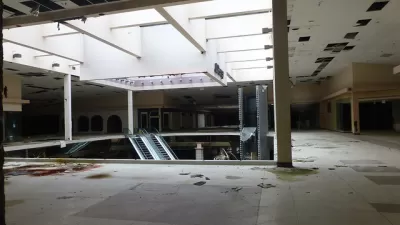What comes next for the doomed, enclosed mall across America? This article highlights a number of solutions, including an adaptive reuse model that incorporates housing units inside the mall itself.
"The mall as we know it today is a mistake.
The lonely box of concrete plopped in the suburban diaspora, outdated and, in many cases, dying, isn't quite what Victor Gruen, the Austrian-born Holocaust survivor largely credited with inventing it, envisioned. Instead, the regional enclosed shopping mall was supposed to be a community center-a little bit of downtown and a car-free haven that would include day care facilities, offices, and, perhaps most importantly, residential living components a stone's throw from the building; the mall was always supposed to have housing nearby.
Perhaps today Gruen would finally be satisfied, because in its newest incarnation, the mall has finally become not just a place to shop, but to live. The mortgage meltdown, shifting demographics and a growing antipathy toward suburban sprawl have caused developers to see malls not as retail dinosaurs but as giant land banks, where going vertical can appease environmentalists, potential buyers and stockholders alike.
It's happening slowly, but it's happening all over America, and industry experts expect the trend to grow. If inner cities are starting to see condo projects go rental or remain unsold, and some new suburban subdivisions are settling into modern ghost towns as the foreclosure crisis deepens, the one bright spot in the housing market might just be here: at the mall."
FULL STORY: Malls, the Future of Housing?

Planetizen Federal Action Tracker
A weekly monitor of how Trump’s orders and actions are impacting planners and planning in America.

Congressman Proposes Bill to Rename DC Metro “Trump Train”
The Make Autorail Great Again Act would withhold federal funding to the system until the Washington Metropolitan Area Transit Authority (WMATA), rebrands as the Washington Metropolitan Authority for Greater Access (WMAGA).

The Simple Legislative Tool Transforming Vacant Downtowns
In California, Michigan and Georgia, an easy win is bringing dollars — and delight — back to city centers.

Albuquerque’s Microtransit: A Planner’s Answer to Food Access Gaps
New microtransit vans in Albuquerque aim to close food access gaps by linking low-income areas to grocery stores, cutting travel times by 30 percent and offering planners a scalable model for equity-focused transit.

This City Will Pay You to Meet Your Neighbors
A North Kansas City grant program offers up to $400 for residents to throw neighborhood block parties.

Commentary: Our Silence Will Not Protect Us
Keeping our heads down and our language inoffensive is not the right response to the times we’re in. Solidarity and courage is.
Urban Design for Planners 1: Software Tools
This six-course series explores essential urban design concepts using open source software and equips planners with the tools they need to participate fully in the urban design process.
Planning for Universal Design
Learn the tools for implementing Universal Design in planning regulations.
Smith Gee Studio
City of Charlotte
City of Camden Redevelopment Agency
City of Astoria
Transportation Research & Education Center (TREC) at Portland State University
US High Speed Rail Association
City of Camden Redevelopment Agency
Municipality of Princeton (NJ)




























